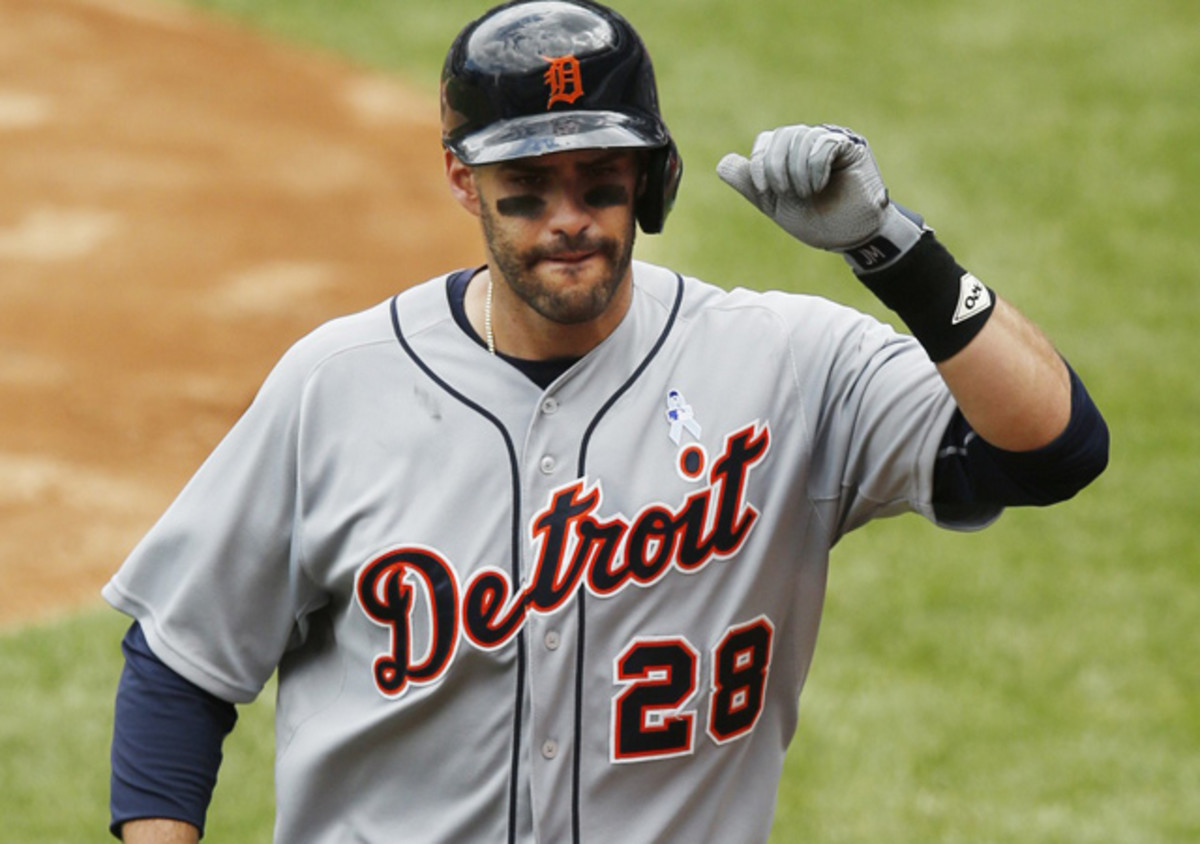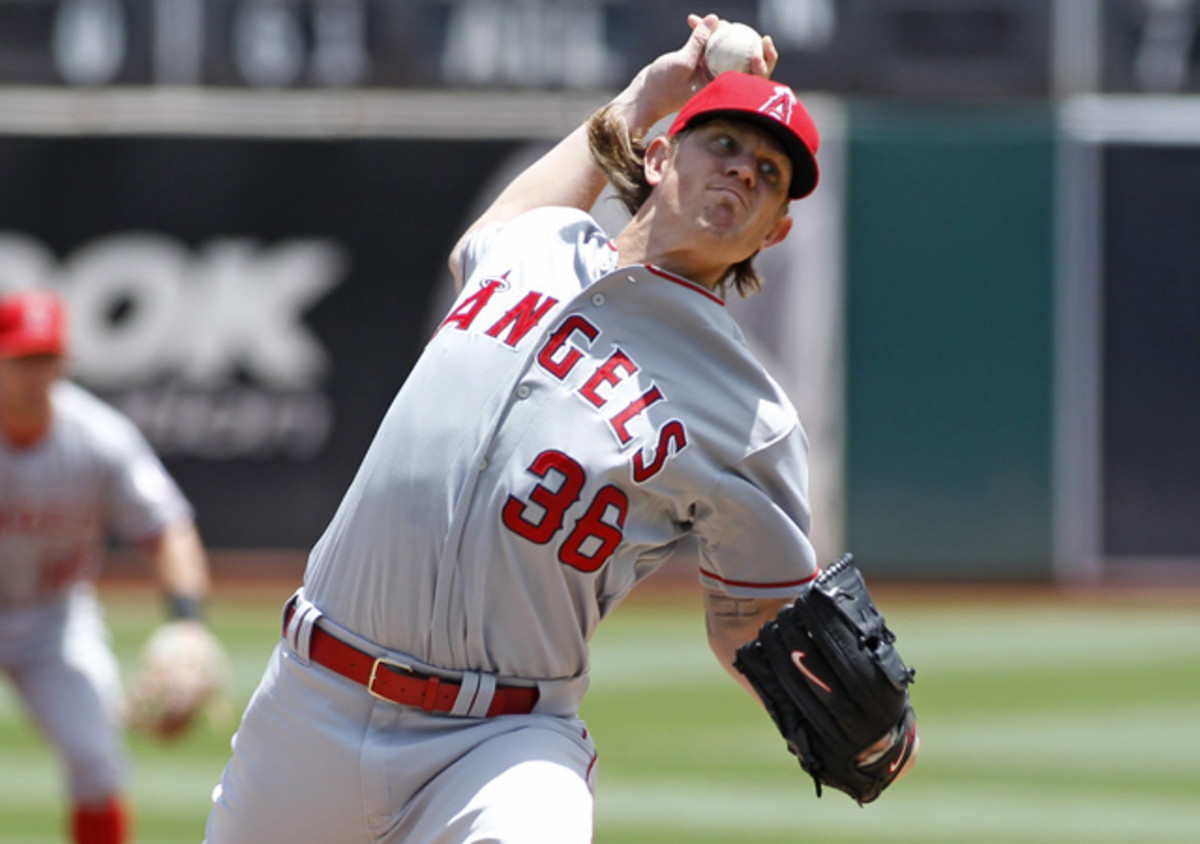Hit and Run: Lincecum running out of rope; J.D. Martinez powers up

1. Freak Out?
Tim Lincecum picked the wrong night for the shortest start of his nine-year major league career. Not only did it cost the Giants a chance to sweep their way into first place in the NL West, but it also left his spot in the rotation in doubt.
On Sunday evening in Los Angeles, Lincecum retired just four of the 12 Dodgers he faced, yielding seven hits, one walk and five runs in a 10–2 loss that knocked the Giants (38–33) 1 1/2 games behind their division rivals (39–31). His two-out walk of Justin Turner in the first inning turned into the game's first run thanks to an Adrian Gonzalez single and a wild pitch, and the only batter Lincecum retired in the second inning was pitcher Brett Anderson, who sacrificed amid a five-hit, four-run rally. The straw that broke the camel's back was a 10-pitch battle with Yasiel Puig following Anderson’s bunt, which ended with the 24-year-old rightfielder stroking a two-run single up the middle. Joc Pederson followed with an RBI double and Turner an RBI single that finally ended Lincecum's night.
Four active players have good chance to join A-Rod in 3,000 hit club
Both in innings and pitches (53), it was the shortest start of Lincecum’s career. Only twice had he previously failed to complete three innings, most recently on Aug. 23, 2014 against the Nationals, an outing that also set his low pitch count for a start at 70. Unfortunately, the 31-year-old righty has been working short far too often lately. Over his last six starts, he's completed six innings just once and fallen short of five innings three times. In that span, he's allowed 22 runs (21 earned) in 27 innings, with 15 walks, six homers and a .910 OPS allowed, a stretch that has nearly doubled his ERA from 2.08 to 3.86.
That 2.08 ERA hails from the point at which I checked in on Lincecum, noting that despite his success to that point, his walk rate and strikeout rates portended trouble. Currently, his 4.3 walks per nine are just one click off his career-worst rate, set in 2012, and his 7.1 strikeouts per nine and 1.6 strikeout-to-walk ratio are career lows. On a per plate appearance basis, both his 18.3% strikeout rate and 11.2% walk rate are career worsts, and his 4.23 FIP is even worse than the 4.05 from his '12–'14 stretch, during which he's been three full wins below replacement level. Even his ground-ball rate, which at the time of that microscopic ERA was a career-best 50.4%, has receded to 44.3%, lower than in any season since '08.
The Sixth Tool: How Michael Brantley and his father built an MVP swing
Beyond his ugly performances, the problem for Lincecum is now a numbers game, because as the San Jose Mercury News' Andrew Baggarly noted, Sunday marked the completion of Jake Peavy's 30-day rehab assignment. Peavy, who made just two starts before going on the disabled list due to a lower back strain, capped his stint with a six-inning start for Triple A Sacramento earlier on Sunday. The situation will get only more crowded by next weekend, since Matt Cain is on his way back as well. Cain hasn't pitched in a regular-season game since last July 9 due to bone chips in his elbow that required surgery and then a flexor tendon strain suffered in spring training. After a 6 2/3-inning stint for Sacramento on Saturday, he has just one more scheduled rehab start before the team has to make a move.
Thus, it appears that two of the team's current starting five will either have to go to the disabled list or the bullpen, and it’s a safe bet that neither Madison Bumgarner (3.09 ERA, 3.29 FIP) nor Chris Heston (3.86 ERA, 3.33 FIP) will be the ones to go. Bumgarner is the staff ace and the only Giants starter preventing runs at a better-than-average clip, while Heston has rebounded from a rough patch with a stretch that includes his June 10 no-hitter. Ryan Vogelsong (4.38 ERA, 4.71 FIP) and Tim Hudson (4.52 ERA, 4.68 FIP) have both been about 20% worse than average at preventing runs, though they're second and third on the staff in terms of quality-start rate (58 and 57%, respectively); Lincecum is last at 36%, which could leave him the odd man out.
Lincecum has gone to the bullpen before—famously, during the 2012 postseason—but with far less fanfare or success late last season after pitching his way out of the rotation. Whether he does move or not, the bottom line is that he’s running out of rope.

2. Martinez Power
The Tigers wasted little time in pouncing on Masahiro Tanaka on Sunday, with Victor Martinez and J.D. Martinez hitting a pair of two-run homers in the first inning. For the former—who collected two other hits on the afternoon, including a two-run single in the second—it was just his second homer of the season and first since returning from the disabled list following a one-month absence due to inflammation in his surgically repaired left knee. For the latter, it was just the start of the biggest day of his career.
Indeed, the 27-year-old leftfielder touched up Tanaka again for a solo homer to lead off the fifth inning, then added a three-run shot in the next frame off Danny Burawa, a reliever making his major league debut. The second homer was the longest of the three, estimated at 433 feet via ESPN Home Run Tracker, and hit to centerfield:
Blame umpires, not Tabata for Scherzer's lost chance at perfection
Those homers, plus one by Andrew Romine, were more than enough to power the Tigers to a 12–4 victory, halting both their losing streak and the Yankees' winning streak at four games apiece. The outburst, which left Martinez with 16 homers and a .275/.333/.516 batting line and 132 OPS+, was the first multi-homer game of his five-year career and the first three-homer game by a Tiger since Miguel Cabrera did so against the Rangers in Texas on May 19, 2013. Martinez became the fourth player to score a hat trick this season, following the Dodgers' Adrian Gonzalez (April 8 versus the Padres), the Nationals' Bryce Harper (May 6 versus the Marlins) and the Reds' Joey Votto (June 9 versus the Phillies).
Since being released by the Astros last spring, Martinez has hit 39 homers with a .300/.349/.539 line and 6.1 WAR for the Tigers, who have certainly needed his production. That's particularly true this season, as Detroit has just three other regulars and one part-timer producing at an above-average clip. Cabrera, who is second on the team with 15 homers, is hitting .346/.450/.593 for a 188 OPS+, all of which lead the league, while Yoenis Cespedes (125 OPS+), Jose Iglesias (115 OPS+) and fourth outfielder Rajai Davis (116 OPS+) have helped. But V-Mart (73) and Nick Castellanos (65) have been dreadful, and Ian Kinsler (91) atypically subpar. As a team, the Tigers rank seventh in the league in scoring (4.25 runs per game), but their pitching has been so thin that they've been outscored (4.32 runs per game, 10th) overall. At 35–34, Detroit is just third in the AL Central, 5 1/2 games out of first place and two games out of the second Wild Card spot.
One other note on the Tigers' day: It was the first time they tallied two first-inning homers in the Bronx since Aug. 28, 1960, when Frank Bolling and Rocky Colavito went deep against Eli Grba.

3. Weaver gets a hip check
With just about every key number of his looking like a red flag, it was clear that not all was right with Jered Weaver. On Sunday, the Angels placed him on the disabled list with inflammation in his left hip, though a prognosis won’t be available until the results of further testing on Monday.
Despite an average fastball velocity of just 85.2 miles per hour according to Brooks Baseball—down nearly six ticks from his peak, and more than two shy of last year’s average—the 32-year-old righty had overcome a rocky start to his season to post a 1.98 ERA and less than a base runner per inning over his final five starts in May. Since the calendar turned to June, however, he’s been roughed up for 20 runs (19 earned) in 26 innings spread over four starts. On Sunday against the Athletics, he yielded four runs on six hits and one walk over 5 2/3 frames.
At the time of the move, Weaver claimed that the injury wasn’t having an effect on his performance, though he did admit to experiencing periodic sharp pains during Saturday’s start as the hip tightened up. Via MLB.com’s Trevor Haas, he said on Sunday, "It wasn't anything drastic, but just something me and [Angels manager Mike Scioscia] thought it would be better to iron out now than toward the end of the season."
A-Rod's 3,000th hit latest milestone in unimaginable feel-good season
Beyond his flagging velocity, Weaver’s 4.75 ERA, 4.80 FIP, 1.5 homers per nine and 47% quality-start rate are all career worsts. The most alarming figure in his stat line, however, is his 4.6 strikeouts per nine—not only well below his career mark of 7.3 per nine, but also tied for the fourth-lowest mark of any qualified AL pitcher. Then again, if one digs even deeper, the numbers get even worse. For example, batters are slugging .586 when they put his four-seamer into play this year, and .487 against his sinker; last year, the numbers were .376 and .422, respectively, and in 2012, the last time he made the AL All-Star team, they were .307 and .342.
Weaver hasn’t been the only under-performer in the Angels’ rotation. Last year’s rookie surprise, Matt Shoemaker, has been lit for a 5.20 ERA, 4.72 FIP, and 1.9 homers per nine, and Garrett Richards has come in with a 3.66 ERA—league average, after adjusting for park—and 3.86 FIP. The rotation as a whole ranks sixth in the league with a 3.98 ERA, but its 4.25 FIP is 12th, and its 1.2 homers per nine is tied for last. At 35–35, the team is third in the AL West, 5 1/2 games behind the Astros, but amid Weaver’s latest struggles, the team has lost 11 of its last 18 games.
As to who takes his spot, Scioscia cited Nick Tropeano, Cory Rasmus and Jose Alvarez, a trio with a combined 17 major league starts: six by Alvarez for the Tigers in 2013, six by Rasmus for the Angels last year and five by Tropeano, four of which came for Houston last season. The 26-year-old Alvarez, the lone lefty of the trio, has been solid in a low-leverage bullpen role for the Angels this season, pitching to a 3.68 ERA and 3.82 FIP with 9.2 strikeouts per nine. The 27-year-old Rasmus hasn’t pitched for the Angels this year and is only two appearances and 1 2/3 innings into a rehab assignment as he returns from core muscle surgery. The 24-year-old Tropeano—who threw six shutout innings against the A’s on April 23, his lone major league appearance this year—is carrying a 5.11 ERA with 8.8 strikeouts per nine in 44 innings for Triple A Salt Lake City.
